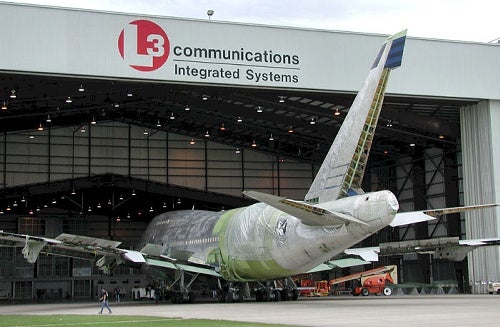The SOFIA 747-SP aircraft, complete with a 98.4-inch (2.5 meter) infrared telescope, is rapidly nearing its first test flight. Under development for 8 years, NASA’s Stratospheric Observatory for Infrared Astronomy (SOFIA) has begun final installation and testing of the complex and challenging sliding Cavity Door system at L-3 Communications Integrated Systems in Waco, Texas. When operational (planned for late 2006) SOFIA will be the largest airborne observatory in the world.
The telescope, designed and built by DLR, the German Aerospace Center, in Bonn, is 3 times the size of the 33.5-inch (0.85m) Spitzer Space Telescope (SST), with 3 times the angular resolution. The SST is cryogenically cooled, giving it superior sensitivity, but SOFIA’s higher angular resolution will be critically important to astronomers. SOFIA is expected to operate for at least 20 years.
Carol Carroll, SOFIA program manager at NASA Ames Research Center in California, expects SOFIA “to be doing science by the end of 2006, and current estimates are that Spitzer will remain operational until December 2008.” This 2-year overlap will be important for scientists.
“We can do follow-up spectroscopic work with more complex instrumentation that is simply too heavy and too expensive to put aboard a spacecraft,” says Eric Becklin, SOFIA chief scientist and director-designate for the University Space Research Association (USRA). USRA will manage SOFIA’s science operations for NASA.
Designing a door to open and close while flying in the stratosphere has been one of the many challenging engineering issues facing the SOFIA project. Flying a jumbo jet at 45,000 feet with a hole 19 by 14 feet wide (5.8 by 4.3m) in the rear fuselage is no easy task.
The huge Cavity Door will swing out of the way to give observers a view of the infrared universe. Since the plane flies well above infrared-obscuring water vapor, the view will be clearer than any possible from current ground-based observatories.
However, the FAA required 100-percent assurance the door’s drive could not function in a hazardous manner, like opening or closing too fast.
The Cavity Door consists of three parts: an Upper Rigid Door (URD); the aperture, a moveable segment that tracks with the telescope pointing; and a Lower Flexible Door (LFD). The aperture and LFD have independent drive systems that work under a single coordinated controller. Wind-sheer controllers ensure smooth airflow across the aperture.
The extra effort for completion of the door is now paying off, and, to the relief of scientists and engineers, the end is in sight. The Upper Rigid Door was successfully installed on December 18. The door installation is expected to be complete in January.
Once the door is completed, SOFIA will take its first flight since the telescope’s installation. Project managers plan to keep the door closed for the first five test flights, slated to begin in late February 2005.
“We’re taking a stepwise approach to our testing. We’ll fly with the door closed, check the flight data, do the open-door flights, analyze the data — completely mapping the aircraft performance to complete the FAA airworthiness tests,” says Carroll. “This will be followed by telescope testing, followed by instrument commissioning.”
Astronomers expect to begin using SOFIA in August 2006, following a critical Operational Readiness Review.
The $484.2-million project, begun in December 1996, overlapped with changes in NASA’s budget following President Bush’s January 2003 announcement of a roadmap to the Moon, Mars and beyond. But SOFIA remains a high-priority mission for NASA, and the observatory apparently will survive the transition unscathed.
Project managers decided to maintain the engineering effort to get the plane in the air in early 2005 and ramp down activities after the first test flight. However, these efforts are eating into the current year’s budget so quickly that the observatory may spend part of the year in a stand-down configuration.
“It’s that important to get the plane in the air and acquire test data,” says Carroll. After the first test flight, the ramp-down period would be filled with extensive post-test-flight analysis, preparations for mission operations, and practice runs of coating the telescope’s large primary mirror. “There’s plenty of work to be done,” Carroll adds.
“SOFIA can observe very high-resolution spectra of objects, opening up the unique science of astro-chemistry by identifying unique gases in the interstellar medium,” says Eric Becklin. “The higher resolution brings huge advantages in complex regions of our galaxy, such as the galactic center.”
Infrared observations of the center of our galaxy allow scientists to peer through obscuring dust along the line of sight because the dust allows infrared radiation to pass through.










